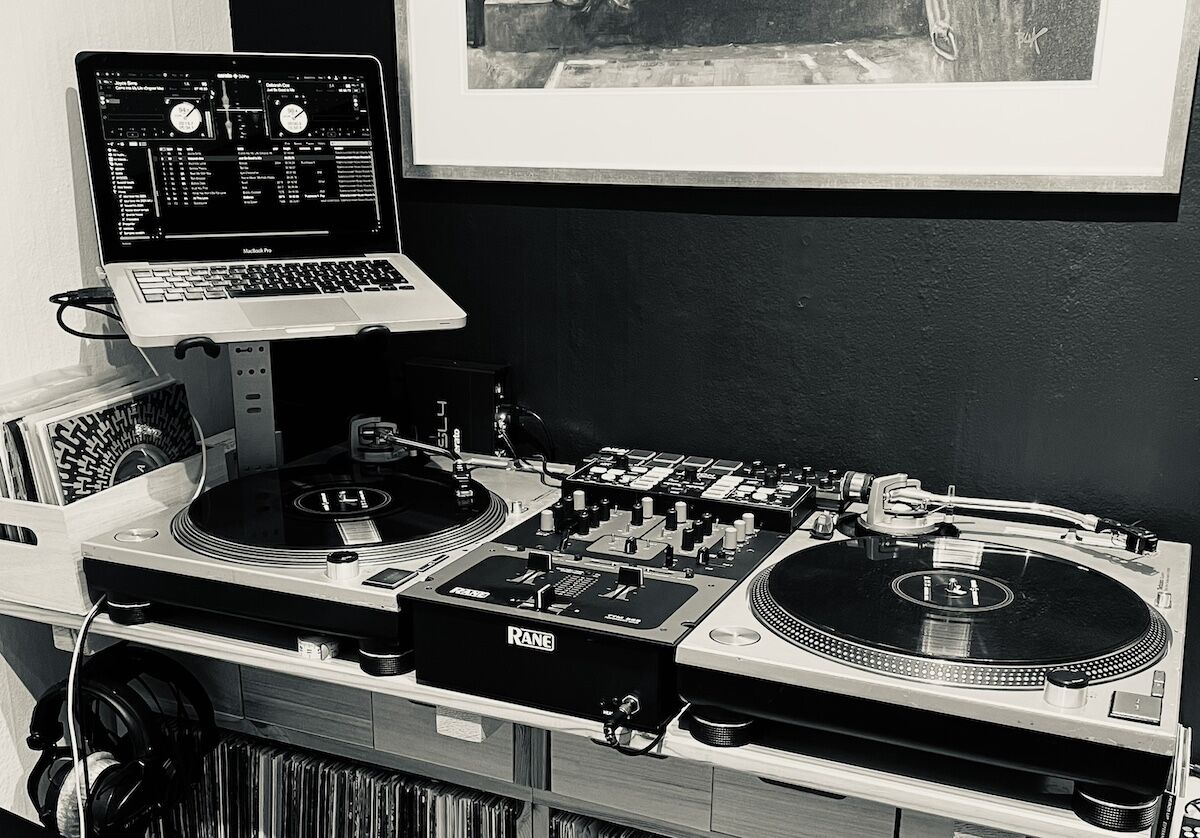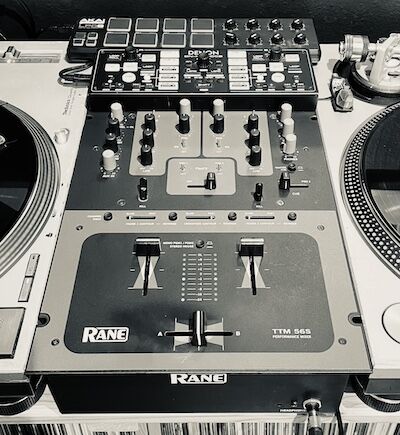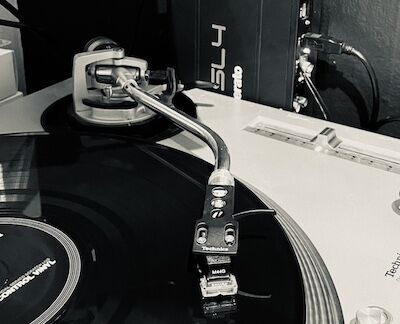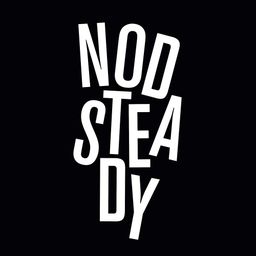My DJ equipment has become vintage
11 Feb 2024 by Nod Steady
Time flies, and I recently discovered that my DJ equipment had become a collection of vintage treasures. For analog equipment, it’s no big deal. For digital equipment that needs drivers, security updates, and use proprietary protocols, it’s a problem.
Back in 2022, the digital parts of my setup was about to become useless. I feared it would require a lot of money to get it working again.
On the plus side:
- My Technics SL-1200 MK2 turntables from 1981(!) are still going strong.
- The Rane TTM56s mixer is discontinued and shows signs of wear, but performs well!
- The Denon DN-HC1000S Serato controller is also discontinued, but works well.
- The Shure M44G needles are discontinued, but there are good options for replacements.
- My Akai LPD8, Beyerdynamic DT-770 Pro headphones, and Ortofon 2M Bronze pickup (my go-tos for enjoying vinyl) are still available for sale in stores.
However:
- My MacBook from 2012 was getting sluggish, the battery was in a bad shape, and it would no longer receive security or software updates.
- My Rane SL-4 Serato box got discontinued in 2022 and isn’t compatible with newer MacBooks, nor the latest Serato versions.
Without the MacBook and Rane SL-4 there would be no more digital DJ’ing. So this soon-to-be useless equipment had to be dealt with, so that I could still DJ for fun!

Digital equipment and age
As digital equipment age, it often becomes unusable due to a lack of software, firmware and/or security updates. This is especially a problem when various equipment is connected and need to be compatible. Replacing one part may force you to replace another. For equipment that is connected to external networks, like the internet, security updates is also crucial.
Without MacOS security updates and a failing battery, the MacBook was getting unusable. And to make it worse, replacing just the laptop wasn’t enough, as the discontinued SL-4 wouldn’t work with a new MacBook. To make matters worse, there were no direct replacements for the SL-4 available at the time – meaning I would have to replace my mixer as well to get one with built-in Serato.
This was a headache. I pondered my options, conducting extensive research.
Options and considerations
The rationale for a new laptop is strong when faced with security risks and a failing battery. But it’s expensive. So is a Serato box replacement. And if I were to also replace the mixer, the total sum would be high.
However, the MacBook is able to run Linux. This would solve the security update issue. And replacement batteries were still available at the time. So I hoped to find some Linux compatible DJ software that would work with the SL-4. But as the SL-4 uses a proprietary protocol, this was a dead end.
In addition to the SL-4, I have an old SL-1 box. If I fixed the laptop and installed Linux, I could perhaps have used this instead of the SL-4, as I think someone has gotten it to work with Linux. I was also considering using two cheap sound cards and hacking it all together using Linux and some compatible DJ software. But these options would be a step down from the SL-4, Serato and MacOS.

Here’s some of my thoughts on these options:
- Money: I was not ready to spend the kind of money needed for replacing all the needed components and get an equivalent to (or something better than) what I already had.
- Sustainability and waste: I don’t like throwing things that are not broken. And I didn’t want to buy new things unnecessarily.
- I didn’t want to replace my current perfectly working setup with a sub-par and hacky substitute – and potentially spend a lot of time in the process.
- The discontinuation of equipment makes me uneasy about longevity: I have no idea how long shiny new equipment would last: Five years? Ten years? As I get older, time goes faster: Ten years used to be a long time, but it’s not anymore.
As for functionality, the last major breakthroughs in DJ equipment was probably going digital 20+ years ago. My equipment was up-to-date on this. The Denon and Akai controllers also provided the extra buttons and pads that is built into many newer mixers. And I even think Phase would work (although I have not tested this).
Replacing broken and worn-out equipment is sometimes necessary. Although it can be annoying, new things can also be fun. Yet, it is not fun to spend a lot(!) of money replacing something that works just to get something that would pretty much be the same.
Bottom line, I liked the Rane SL-4, I liked Serato DJ Pro, and I liked my MacBook and MacOS. It was stable, I knew how to use it, it worked great, and I didn’t miss any functionality. I also liked the modularity of the Rane SL-4 box: It gives flexibility that the mixers with built-in Serato does not have.
What did I do?
So after researching and pondering my options, here’s what I did:
- I replaced the MacBook battery. And I disconnect it (forever!) from the internet. No internet means no need for security updates. New music gets copied to it via a USB memory stick.
- I kept the Rane SL-4, as staying with the old MacBook, OS version, and Serato Pro DJ 2.5.5 (the last version supporting it) means it will still work.
- I replaced the MacBook hard drive with an SSD to improve speed.
The main downside is no internet – which I don’t really need on this laptop.

As for the rest of my equipment, the turntables have lasted for over 40 years. I have replacement pitch controls and phono cables, and the spindle/shaft has been replaced earlier. They will likely last for many years to come.
Mixers do get worn out, but the TTM56s will last a bit longer and can probably be fixed up when needed: Crackling potentiometers can be dealt with and there seems to be spare parts available (and I even have an unused Innofader PRO 2).
There are good replacement options for the needles. And if needed, the Denon controller could be replaced with any MIDI device, as Serato supports MIDI mapping.
So there you have it: I run on vintage DJ gear that is capable of most things modern DJ equipment is capable of – except connecting to the internet.
Additional Insights & Afterthoughts
After I concluded, Reloop has released Flux, which is an equivalent to the SL-3 (the little brother of SL-4). This would have been a suitable replacement for me. I even think it works with Linux, as I believe it is a class-compliant USB device (but I haven’t researched this thoroughly, so please check for yourself if you’re interested). However, if it had been available when I was researching this, it would have been necessary to replace the laptop regardless, or using it with Linux and a new battery. So what I opted for still works better for me.
As for the laptop battery, seems like I was last minute getting a replacement: The workshop initially told me replacement batteries were not available as the laptop was vintage. But they eventually managed to find and order an original battery. I don’t know if they’re still available for 2012 MacBooks, this was back in 2022. So if you are to refurbish an old laptop, make sure to do it while spare parts are still available. And as laptop batteries are dangerous, use originals and get the work done by a certified workshop. And also make sure to use an OS that received security updates if you are to connect it to the internet.
I also have another 2012 MacBook Pro Retina that I use just for surfing the internet. This one also got a replacement battery. But as this one needs internet, it now runs Pop!_OS Linux from System76. I had to fiddle some to get the fans working to prevent overheat, and it needed wired internet to get some updates to get WIFI working. Except for keyboard layout being a little unusual, it works great.
P.S. If I were using my DJ equipment every day or for work, I may have thought differently about some things.
P.P.S. The Innofader PRO 2 was bought for my Ecler HAK 360, my all time favourite mixer. But the Ecler needs some serious refurbishing before it is ready to be used again.
